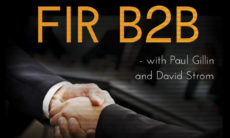Overview:
There are four primary elements of a B2B targeted marketing campaign:
- Targeting, segmentation and list selection
- Offer for response
- Contact media sequence and frequency
- Creativity
Of the four, no experienced B2B marketer disagrees that the targeting, segmentation and list element is the most important. Over the years various experts have said that this element is worth from 50-70% of the campaign’s success, and I agree. After a careful targeting and segmentation process, the next task is to find a list that aligns with those companies and individuals called out for the campaign’s execution, whether it is for lead generation or customer relationship building or retention.
This is where the problems begin. Simplistically, there are two sources of lists – internal and external. Internal lists are primarily customer or past lead lists. In most B2B campaigns, the objective is to find new potential customers. No news there. What is news is the high inaccuracy of B2B data and lists, whether they are internal or external. For this post we will focus on outside lists.
Yearly B2B Data Decay Rates
We all know that B2B data is less accurate than B2C data for a number of reasons, and one of them is that it decays far faster than consumer data. In 2009, we updated our original 2002 study on B2B Data Decay that has been cited by Dun & Bradstreet, Zoom, Jigsaw (now part of Salesforce.com) and others.
In brief, the study showed that on average B2B data decays at a rate of just over 5% per month, or 70.3% per year. Think of an individual’s business card, as that’s how we gathered these surprising statistics. Here are the results of over 1,200 cards handed in by individuals who participated in the survey. They were simply asked what has changed on their business card in the last 12 months. In other words, this is self-reported data which has proven to be as accurate as any B2B source. If there were no changes, the card was still collected and scored as such.
Here are the results:
- 3.8% name change (women still do change their name upon marriage/divorce)
- 65.8% title and/or job function change (changed firm or new job in the same firm)
- 41.9% address change (changing companies or company/individual’s relocation)
- 42.9% phone number change (changing companies and company move as above)
- 37.3% email address change (slightly less than above as some use personal email address)
Upon further analysis we were able to gather a few more data decay statistics. They are:
- 29.6% of individuals changed companies (new job)
- 36.2% of individuals changed jobs in their company (promotion or reorganization)
- 4.6% of the companies changed their name (merger or rebranding)
- 12.3% of companies moved office locations
Historically when list brokers and compilers were asked about this decay rate, they most often responded that it was about 25-30%. A gross underestimate, as they were reporting only those individuals who left the firm, and totally missed the individual’s changes within the same company. Since we sell individuals and not companies, it is critical to have the individuals contact information correct. (To obtain the full report email me John.Coe@B2BMarketing.com)
An Outside List Example:
During the last 3-months we have been working on a lead generation campaign for Adeptpros (www.Adeptpros.com), a developer of apps. The clear target is CTO’s in medium size ($35MM) to large companies (no upper size limit). As this campaign started with a high impact direct mail package costing $25, we wanted to get the best list possible, and then call to verify the key data before sending the DM package.
Bill Lidle, Sr. VP at Adeptpros and I were both aware of a well known high technology list that was touted to be very accurate, as they promoted that all their company records were phone updated and verified within a 12-month period. We ordered the complete company record, and as a result, the list was quite expensive at $3.50 per company record. It did contain multiple contact names of all the C-level staff. This is where the surprises started, and here’s what Bill reported upon phone verification of 128 records:
- Of the records screened before call verification, 50% showed no revenue or revenue below the $35MM criteria. A disconcerting result to say the least, but this could be chalked up to a poor data pull. We assumed something had gone wrong in the instructions.
- Upon phone verification, the real surprise occurred. Of 128 records phone verified only 48 had the correct contact name, company name, revenue, and HQ address. In other words, almost 62.5% of the records were wrong in one or more key data elements that we needed for the campaign. Here are three examples of the incorrect information from phone verification done by Adeptpros: (The last names of contacts are withheld for privacy reasons).
- NelNet showed Steve G. as President, but he actually left the company in 2000 – more than 13 years ago! Key contact name was also wrong.
- First California Bank had been acquired by Pacific Western Bank in 2012, even though the deal didn’t close until 2013. Sara P. was shown as CIO but in early 2012 she moved to VP Risk Manager – company and contact name wrong.
- Premier Global Services changed name to PGI in 2010, plus the location provided was a regional office and showed revenue of $66MM. The actual HQ was actually in Atlanta, and the company had revenue of $5.3B. The VP of Global IT was shown as Brian S. but he left the company in 2011 – company name, address, revenue and contact name wrong.
Obviously, the list was not as promoted, and in fact, not even close to what was needed by Adeptpros. We ordered another list and are checking it now with crossed fingers.
Buyer/Renter Beware!
Is this a common problem, or is this an outlier? From my experience, this is a very common problem, and should send a strong warning to any B2B marketer or agency when ordering lists. Try the following when considering a B2B list from any source, particularly if the communication is important and/or the out-bound cost is high:
- Determine the verification and accuracy process with the list vendor and establish a minimum guarantee of list accuracy. This guarantee may vary depending on the data elements and, as an example, it is common to guarantee a 95% deliverable rate on direct mail, but not email or contact name accuracy.
- Ask for other users of the list for reference checking on quality. At times list brokers or managers do not like to divulge client names, but press anyway.
- Ask for 100 records drawn by Nth name from the potential list to be rented or purchased. Many times this will not be made available, so an alternative is to place the order with the provision that if a check of 30 records does not meet the guarantees, a return or credit is allowed. You will need to report the specific data errors and believe it not, most list vendors will thank you for this.
- If these suggestions are not possible to archive, still do your own verification of 30 records so you at least know the quality of the list before launching your campaign. Knowing the quality will help you prepare to understand the results.
Think of it this way. If the list is 25% inaccurate and your response rate was 2%, then the actual response rate was 2.67%, as 1 out of 4 individuals never received the communication.







[…] within a company, and companies restructure. Your information won’t be valid forever. In fact, up to 70 percent of B2B contact information is out of date within a year of acquiring it. A CRM can help you track the age and reliability of your info, and you can cross-check third-party […]
[…] LinkedIn is a great place to start since it’ll give you job titles and places of employment. You can follow up with phone verification, but that’s time-consuming and might not be worth the effort, depending on the type of account you’re after. There are also third-party data vendors you can use to find info, but make sure you keep everything up to date — 70 percent of B2B data is out of date after 12 months. […]
[…] info, but in keeping it up to date. This is a serious concern — according to one study, 70 percent of B2B contact info will be out of date a year after it’s acquired, and in some industries, that decay is even faster. A CRM will let you track how long it’s been […]
[…] relationships with the companies on your list will rely heavily on knowing who to talk to. Since 70 percent of B2B data is out of date within a year of receiving it, it’s vital that you have someone on board who can keep up with the constantly shifting people […]
[…] that B2B data is a bit like fresh produce — decaying at a rate of 70% (!) per year — this is a task that many businesses struggle […]